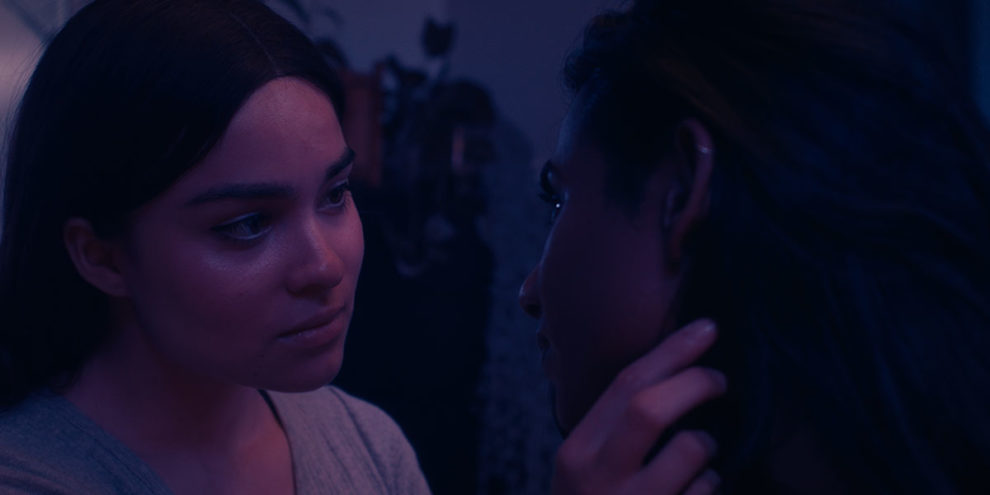There's a first for everything… and “This Place” marks the first film I've seen that weaves Indigenous and Asian heritage into a single production. A diverse, mostly BIPOC crew seem to be responsible for the magic. First-time feature director V.T. Nayani teams up here with Kawennáhere Devery Jacobs (“Reservation Dogs”) and newcomer Golshan Admoulaie, who each identify as Tamil, Mohawk and Iranian, respectively. Over the course of the last nine years, the trio have come together to come up with a cultural saladbowl of a movie. In “This Place,” ethnic differences transcend the feeling of displacement, where lonely souls are left seeking each other out on the streets.
This Place is screening at Toronto International Film Festival

“This Place” witnesses the increasingly intertwined lives of two women. Jacobs herself plays Kawenniióhstha, a half-Iranian, half-Mohawk aspiring poet who moves to Toronto alone. The city is rife with opportunity for her. On the one hand, she knows her estranged Iranian father is in-town; she burns to introduce herself to him for the first time. On the other hand, she finds – and falls in love with – Malai (Priya Guns), a Tamil undergraduate student with a penchant for math. Their blossoming romance quickly becomes complicated, however, because of their families. While Kawenniióhstha seeks out her father, Malai is on the brink of losing hers. While Kawenniióhstha's mother calls her home to the Kahnawà:ke Mohawk Territory, Malai's brother beseeches Malai back into their apartment. Their dream of living happily ever after together seems increasingly impossible by the day – until Kawenniióhstha decides to make the first move.
As a veteran actress, Jacobs captures Kawenniióhstha's repressed anxiety and discomfort in a new city to the T. Newcomer Priya Guns, however, has been an entertaining watch. Her performance is inconsistent; her lines falter when she is not as comfortable with an actor on-screen. Her eagerness around Jacobs, however, is palpable. Though their first meeting seems awkward – why is she that interested in hanging out with a stranger? – she loosens up over time. Guns relaxes into a suave tenderness that Jacobs visibly responds to, alighting the fire of their characters' romance.
Beyond Jacobs' and Guns' performances, Kawenniióhstha and Malai's bond only feels surface-level, however. The characters only seem to bond over two things throughout the movie: their mutual physical interest and their shared ancestral history with genocide. This may be due to the grassroots approach. Unlike some other character-driven queer films like “Rafiki” (2018) or “Portrait of A Lady on Fire” (2019), “This Place” seeks to zoom out of a protagonist or even couple-driven story. Instead, it seeks to track the movement of the various villages floating about Kawenniióhstha and Malai. The familial tension does not seek to shove a wedge between them; instead, it threatens to drift them apart. By fleshing out Kawenniióhstha and Malai more fully, we witness how not just their relationship, but the communities they grew up in.
That being said, “This Place” has far too much going on for it to last less than 90 minutes. Nayani is a tad too generous with jumping scenes. Just when we begin to revel in Kawenniióhstha and Malai's romance, Nayani cuts to another location. This abrupt change in pace feels less experimental than it does amateur; it feels like Nayani is rushing herself for the sake of the viewer's time. In this vein, Nayani ends up seeming more invested in telling the characters' backstories instead of allowing her viewers to soak in the atmosphere of her film. On that note, her lack of attention to the music is telling. While she pays close attention to moody lighting and capturing the texture of pigmented skin, generic violins grate against the ears. The score retracts rather than adds to the film's already on-the-nose direction.
“This Place” is not completely irredeemable, though. With a mostly BIPOC and queer crew, Nayani's feature film points to an exciting new direction in Asian diasporic movie production. Within the larger picture of Asian Canadian / Asian American film, Nayani's case is also particular in that it steps away from the ethnocentric exclusivity in the overarching search for “authenticity.” Her attempt to find similarities across cultures is admirable – but for a character cast this complex, she needs to allow herself more time to tell her story.
















